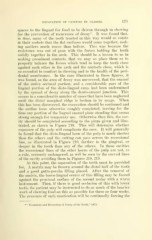Page 389 - My FlipBook
P. 389
EXCAVATION OF CAVITIES BY CLASSES. 171
spaces to the lingual for food to be driven through in chewing
for the prevention of recurrence of decay*. It was found that,
in time, many of the teeth treated in this way would so rotate
in their sockets that the flat surfaces would come together, mak-
ing matters much worse than before. This was because the
resistance was out of pose with the forces holding the teeth
solidly together in the arch. This should be a lesson to us in
making prominent contacts, that we may so place them as to
properly balance the forces which tend to keep the teeth close
against each other in the arch and the contacts close, which is
so essential to comfort in chewing and to the health of the peri-
dental membranes. In the case illustrated in these figures, it
was found, as the area of decay was uncovered, that the enamel
of the entire occlusal portion, and a considerable part of the
lingual portion of the disto-lingual cusp, had been undermined
by the spread of decay along the dento-enamel junction. This
occurs in a considerable number of cases that have been neglected
until the distal marginal ridge is broken in by usage. When
this has been discovered, the excavation should be continued and
the outline form otherwise roughly completed, leaving for the
time any portion of the ling-ual enamel plate standing that seems
strong enough for temporary use. Otherwise than this, the cav-
ity should be completed according to the plans given and illus-
trated, as shown in Figure 218. This will determine whether
exposure of the pulp will complicate the case. It will generally
be found that the disto-lingual horn of the pulp is much shorter
than the others and the cutting can pass across its recessional
line, as illustrated in Figure 219, farther to the gingival, or
deeper in the tooth than any of the others. In these cavities
the recessional lines of the other horns of the pulp are not, as
a rule, seriously endangered, as will be seen by the curved lines
of the cavity avoiding them in Figures 218, 219.
At this point, the separation of the teeth must be provided
for. A matrix may be thrown around the distal half of the tooth
and a good gutta-percha filling placed. After the removal of
the matrix, the bucco-lingual center of this filling may be forced
against the proximal surface of the second molar with a warm
instrument. Then, if there is good occlusion of this with lower
teeth, the patient may be instructed to do as much of the heavier
work of chewing food on this as possible for three or four weeks.
The pressure of such mastication will be continually forcing the
* " Treatment and Prevention of Decay of the Teeth," 1871.


